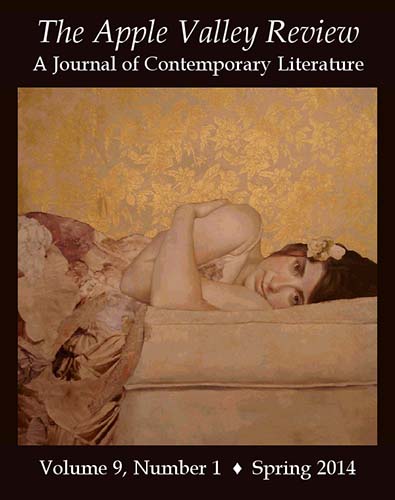Apple Valley Review – Spring 2014
Apple Valley Review is definitely a journal to watch, with excellently crafted prose and engaging verse. This particular issue boasts three fictions, one nonfiction, and thirteen poems. Dave Patterson “A Return to Rothko” is enchanting with the innocence of a child’s (and then man’s) reaction to death, along with his mother’s idea that there is something wrong with him because of it. The brilliance is in the small details, the illustrations that further the characters. When he is a child, the narrator plays with his dead dog; at only eight years old, he’s fascinated with the idea of death and is still learning what it really means… Apple Valley Review is definitely a journal to watch, with excellently crafted prose and engaging verse. This particular issue boasts three fictions, one nonfiction, and thirteen poems.
Dave Patterson “A Return to Rothko” is enchanting with the innocence of a child’s (and then man’s) reaction to death, along with his mother’s idea that there is something wrong with him because of it. The brilliance is in the small details, the illustrations that further the characters. When he is a child, the narrator plays with his dead dog; at only eight years old, he’s fascinated with the idea of death and is still learning what it really means:
Prying open her mouth, I place my hand on her tongue. I’m delighted by the danger of having my fragile child’s hand inside the mouth of a beast. With my index finger, I press the jagged edge of each tooth. The gums are black and pink, and I run my finger along the smooth surface. I squeeze her rubber tongue in my hand. The roof of her mouth is ridged and gives me goose bumps when I scrape it with my fingernail.
. . . . . . . . . . . . . . . . . . . . . . . . . . . . . . . . . . . . . . . . . . .
I fear she might come back to life and bite me like she once did when I jerked her tail. This thrills me. I jerk her tail again and again now. Harder and harder. Each tug satisfies.
While I admit I don’t fully understand “Return to Bear Creek” by Louisa Howerow, it is a poem that I read over and over—certainly something every poet hopes for. The elements of spring, and egg-dying from bloodroot, were very interesting: “I left her to her stylus, / wax lines crossed on empty / eggs she then dyed red—” Then I noticed a note on the bottom that says this poem started as a free-write for Howerow about her own memories of spring.
Kelly Scarff’s prose poems “On Planning” and “On Timing” work well together: both simple, both inspired by loss, and both with imagery heavily laden with intent. And via images of a walk through one’s typical day, Abby Rosenthal’s “Whatever Happened?” shows how time so easily slips away and how we age faster than we think: “yet we can’t help noticing how dusk / comes a little earlier / than the night before.”
Vivian Wagner’s essay “How to Go Through Your Dad’s Things After He Dies” is like taking a walk through a museum of someone else’s life, but it’s short—the walk, not the life. Delineated in four steps, the essay makes me wish there was more. There’s something very poetic about going through someone’s junk: “Also read sticky notes with reminders to himself about trash pickups and medications, highlighted printouts of your Twitter feed, annotated copies of your essays, notes he took on phone conversations with your sister, and lists of numbers that you study with the care and diligence of a Torah scholar . . .”
My only qualms with the journal is the inability to bookmark individual pieces or flip back and forth with the “back” button (every page is the same URL). But otherwise it’s in a simple format and holds high quality work. The bios and inspirations from the writers at the bottom of each piece add to the overall experience—an experience that is both unique and enjoyable.
[www.applevalleyreview.com]






